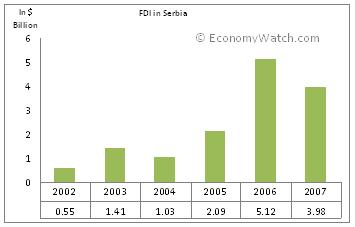Serbia Economy
Please note that we are not authorised to provide any investment advice. The content on this page is for information purposes only.
Serbia, located in Southeastern Europe, was a part of the Federal Republic of Yugoslavia along with Montenegro. In May 2006, Serbia officially split from the federation to form an independent nation. Serbia is a land-locked country, bordering Bosnia and Herzegovina, Bulgaria, Croatia, Hungary, Kosovo, Macedonia, Romania and Montenegro. With a total land area of 77,474 sq km, Serbia economy struggles with a small domestic market.[br]
Serbia, located in Southeastern Europe, was a part of the Federal Republic of Yugoslavia along with Montenegro. In May 2006, Serbia officially split from the federation to form an independent nation. Serbia is a land-locked country, bordering Bosnia and Herzegovina, Bulgaria, Croatia, Hungary, Kosovo, Macedonia, Romania and Montenegro. With a total land area of 77,474 sq km, Serbia economy struggles with a small domestic market.[br]
Serbia Economy: Overview
Political instability has been a key detriment to Serbian economy. However, increased efforts towards economic reforms by the Serbian government helped the nation attain a growth rate of 6% in 2006. The economy of Serbia continued to improve during 2007, registering a robust growth rate of 7.5 %. The global financial meltdown of 2008, however, pulled down the growth rate to 6.1%.
The effect of the global financial crisis also spilled over to Serbia stock market, with the indexes plummeting significantly and the Serbian Dinar devaluing by over 30% vis-à-vis US Dollar and 12% vis-à-vis Euro. The Serbian government signed an agreement with the IMF, enabling it to draw a loan worth $3 billion to bolster its macro-economic stability.
Some key indicators of Serbia economy during 2009, according to CIA World Factsheet reports, were as follows:
|
Economic Indicator
|
Value
|
|
GDP Per Capita (Purchasing Power Parity) |
$77.01 billion |
|
GDP (Official Exchange Rate) |
$42.39 billion |
|
GDP – per capita |
$10,400 |
|
Unemployment Rate |
18.8% |
|
Inflation (CPI) |
11.7% |
Serbia Economy and Foreign Investment
The government of Serbia is focused at attracting foreign direct investment, which offers financial as well tax incentives to foreign companies that invest in the nation. Presently, major foreign investors in Serbia belong to the EU, including Austria, Greece, Germany and Norway. Several blue-chip companies have a strong presence in the nation, including US Steel, Microsoft, FIAT, Coca-Cola, Siemens and Carlsberg.[br]
The foreign investment trend over the past few years in Serbia economy is illustrated in the graph below:
(Source: UN Conference on Trade and Development)
Serbia economy is thriving because of increasing FDI. In fact, a poll by the German Chamber of Commerce, voted Serbia as the top investment destination in the South-Eastern Europe region. While EU continues to be the major contributor of FDI in Serbia economy, greater investment is being undertaken by several non-EU nations, including India and Russia.





